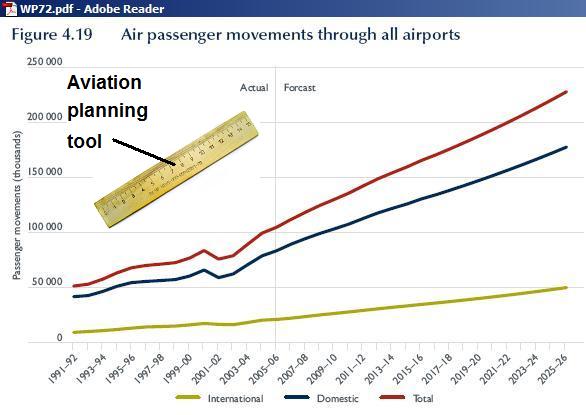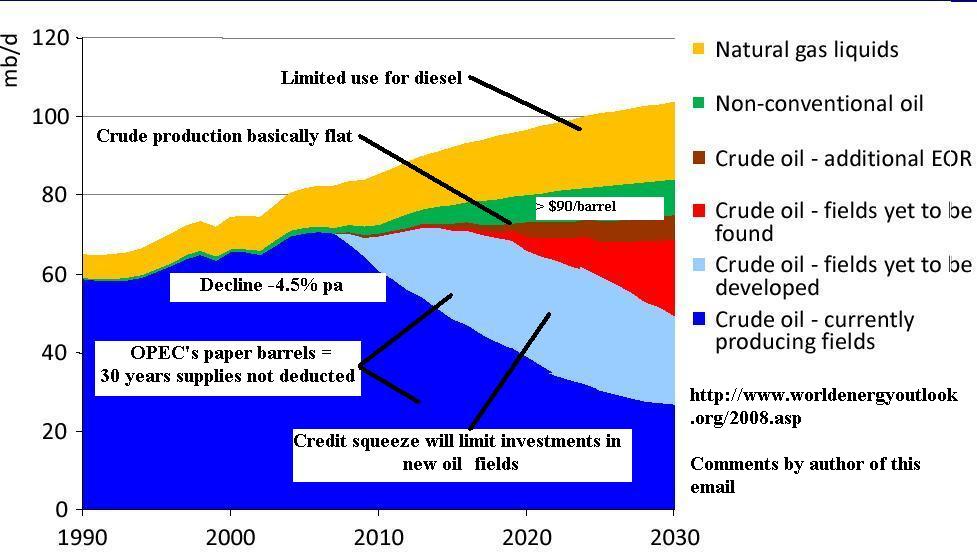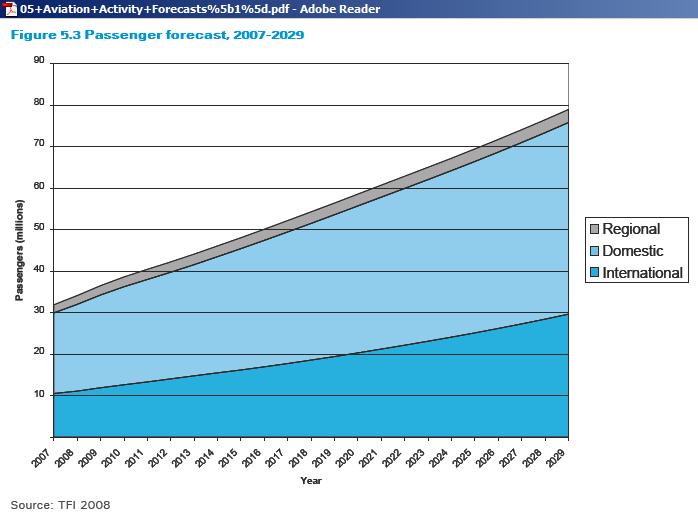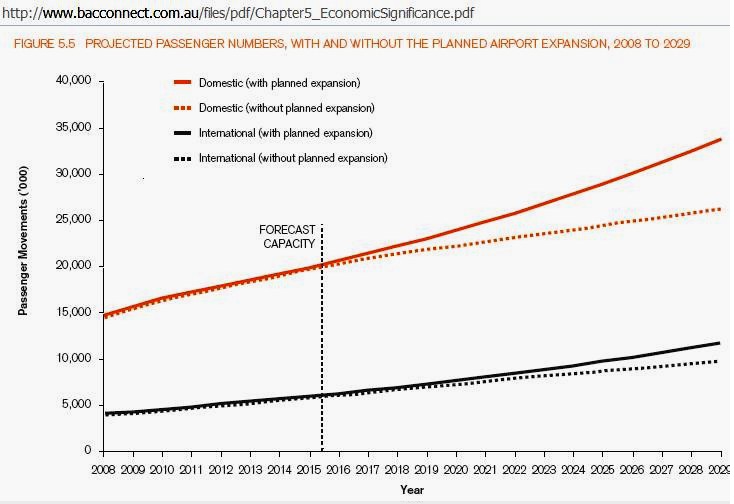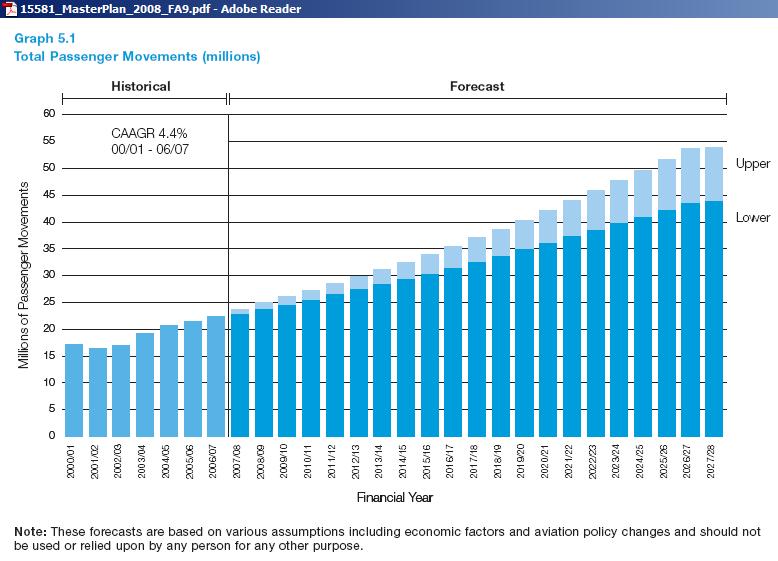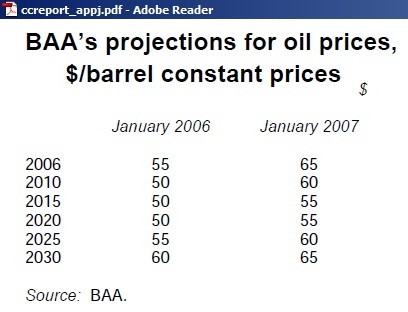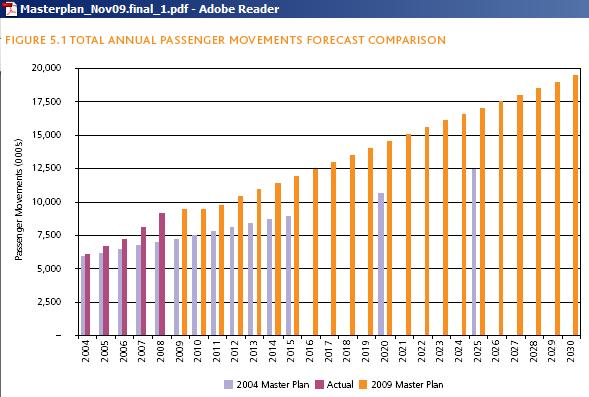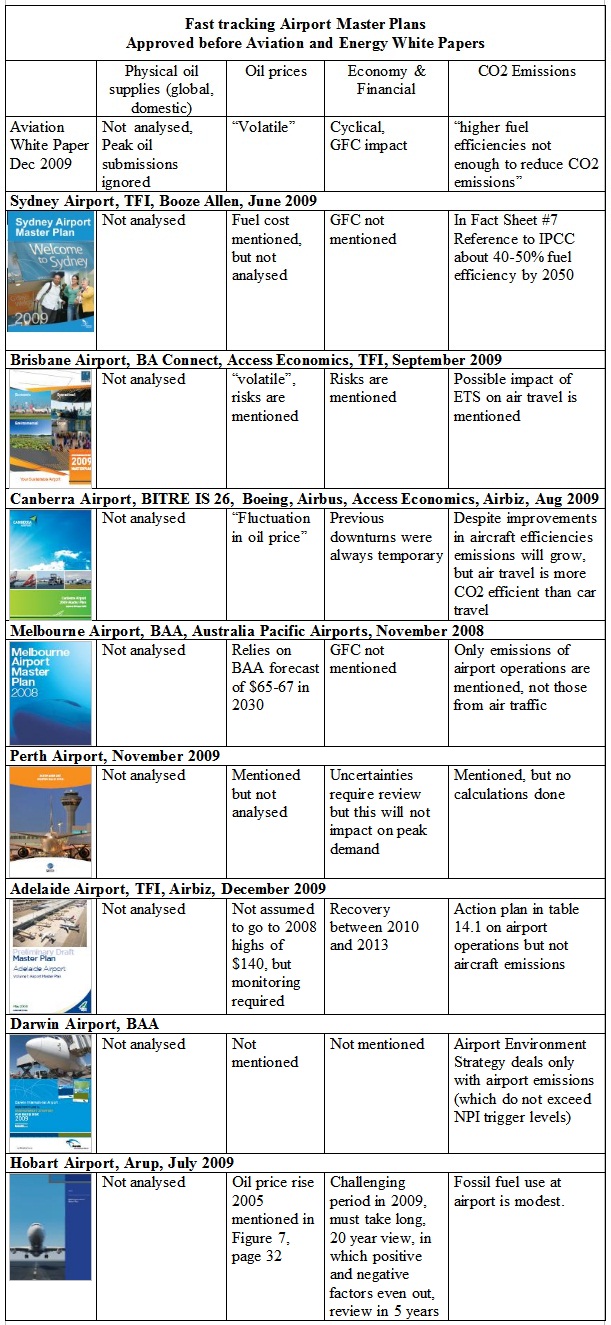In 2009, the Federal government released both an aviation green and white paper. At the same time airports around Australia published their master plans, all assuming a doubling of air traffic within the next 20 years as shown in the BITRE working paper #72:
Even taking into account that growth in aircraft movements is somewhat lower (60% – 80%), this is hardly realistic if under the most optimistic assumptions of the International Energy Agency (IEA, WEO 2008) crude oil production will stay basically flat over that period:
None of the aviation documents considered physical limits to oil supplies. Nor did any of the airport plans at least formally refer to the energy white paper (EWP), which was under work at the same time but not completed by the end of 2009. This is irrespective of whether EWP related documents published so far deal with peak oil or not.
1 Federal aviation policy
The following table shows the interdependencies between different documents relating to the aviation white paper
(a) BITRE Working Paper 72: Air passenger movements through capital city airports to 2025-26, June 2008
http://www.bitre.gov.au/publications/2008/wp_072.aspx
Sensitivity analysis
Scenario 1 assumes that fuel prices decline by 50 per cent from the base case level and Scenario 2 assumes that they increase by 50 per cent. The base case is defined as a medium scenario that reflects the economic and political conditions as at early 2008. Forecasts of air passenger movements presented in Chapter 4 are the base case forecasts. (Page xxv )
http://www.bitre.gov.au/publications/2008/files/wp_072.pdf
(b) BITRE Report 115: Air Transport Services in Regional Australia: trends and access, July 2008
http://www.bitre.gov.au/publications/2008/report_115.aspx
http://www.bitre.gov.au/publications/2008/files/report_115.pdf
(c) BITRE Avline13, Historical and future air traffic growth at Australia’s capital city airports, December 2008, release date February 2009
http://www.bitre.gov.au/publications/2009/avline_013.aspx
http://www.bitre.gov.au/publications/2009/files/avline_013.pdf
(d) Aviation Green Paper, Flight Path to the Future, Dec 2008
http://www.infrastructure.gov.au/aviation/nap/green_paper.aspx
http://www.infrastructure.gov.au/aviation/nap/files/Aviation_Green_Paper.pdf
(e) Aviation White Paper, Flight Path to the Future, Dec 2009
http://www.infrastructure.gov.au/aviation/nap/index.aspx
http://www.infrastructure.gov.au/aviation/nap/files_white_paper/091215_Full.pdf
The aviation white paper writes:
“Aviation fuel is a critical component of the aviation supply chain. Fuel is an obvious prerequisite for the operation of aircraft, and can potentially comprise up to 30 per cent of an airline’s overall cost base. Demand for jet fuel in Australia has been steadily increasing. In the two decades to 2006-07, consumption of jet fuel in Australia has risen by an average of 4.3 per cent a year.40 Despite ongoing improvements in aircraft fuel efficiency, jet fuel use is expected to continue to rise in future years, broadly reflecting growth in industry activity.
Several submissions to the Aviation Green Paper expressed concerns in relation to the availability and price of aviation fuel at Australian airports. These submissions highlighted recent disruptions to fuel supply, and have suggested that these problems could be rectified by introducing greater competition to the aviation fuel supply market.” p 187
Footnote 40 in:
Peak oil is not mentioned despite the submission from ASPO
and my own submission on the Green Paper on Aviation
http://www.crudeoilpeak.com/?p=43
This peak oil ignorance is not a surprise, it is almost systemic. For example, the above footnote 40 refers to an Oil Import Infrastructure report by ACIL Tasman, a consultant who helped the government take the peak oil issue out of the energy white paper, as shown in:
15/1/2010, Report Card 2009 (part 1) – Energy Policy – Has the Federal Government prepared for declining oil production? http://www.crudeoilpeak.com/?p=948
My detailed comments on the aviation white paper are here:
17/12/2009, Aviation White Paper argues debt crisis down, ignores peak oil, means flight path to a stormy future http://www.crudeoilpeak.com/?p=838
2 Airport Master Plans
Airport Masterplans have to be prepared according to Division 3 of the Airports Act 1996
and airport regulations. Airport operators must specify the development objectives and the future needs of civil aviation users (clause 71.2) for a planning period of 20 years (clause 72), with review periods of 5 years (clause 77).
However, a resource analysis is not required. This means this Act is now out-dated and has to be amended. The following graph from Prof. Aleklett, president of ASPO, Sweden, shows clearly the emerging gap between demand (need) and production of aviation fuels:
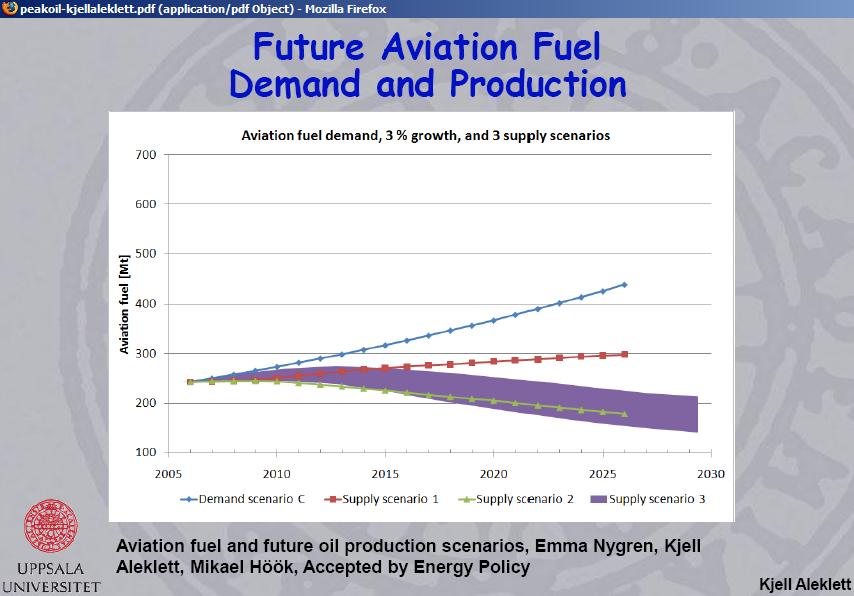 http://aleklett.wordpress.com/2009/05/03/aviation-fuel-and-future-oil-production-scenarios-%E2%80%93-%E2%80%9Cpeak-aviation
http://aleklett.wordpress.com/2009/05/03/aviation-fuel-and-future-oil-production-scenarios-%E2%80%93-%E2%80%9Cpeak-aviation
The impact of future oil prices is mentioned in some of the airport plans, but not realistically assessed. In the case of Melbourne, for example, advice was taken from the British Airport Authority BAA that oil prices would be $65 a barrel by 2030!
Interruptions to air traffic growth from events like 9/11, SARS and economic downturns are recognised but in general it is assumed that past growth trends will resume and continue linearly over the next 2 decades. Peak oil of course is not a temporary or a cyclical event but a fundamental change. It is not clear whether aviation planners
(a) do not know about peak oil
(b) know about peak oil but think there will be replacement fuels
(c) think peak oil is far into the future or deliberately ignore it
2.1 Sydney
Website Sydney Airport Masterplan, submitted to the Minister for Infrastructure in March 2009: http://www.sydneyairport.com.au/corporate/community-environment-and-planning/master-plan
The forecasts for passengers and fixed wing aircraft movements prepared for this Master Plan cover the 20 year planning period to 2029 as required under the Act. The annual and representative busy day forecasts, which appear throughout this Master Plan, were prepared for Sydney Airport by the Sydney based consultancy Tourism Futures International. An independent peer review of the forecast methodology was undertaken by Booz Allen Hamilton.
The forecasts are based on relationships between key drivers and traffic. Separate models for both international and domestic/regional passengers and aircraft movements were developed taking into account:
• economic factors – the Organisation for Economic Cooperation and Development Gross Domestic Product (GDP), Australian GDP, Australian Trade-Weighted Index and NSW Gross State Product;
• population – forecasts of population for overseas visitor markets, Australia and Australian States and regions; and
• aviation factors – such as airline capacity, air fares, fuel costs, and airline schedules
Comparisons were made with projections from Australia’s Tourism Forecasting Committee, Bureau of Infrastructure Transport and Regional Economics and the International Air Transport Association. Sydney Airport’s fares were found to be generally consistent.
5.4 Passenger forecasts
The passenger forecasts for Sydney Airport indicate growth from 31.9 million passengers in 2007 to 78.9 million passengers in 2029. This represents annual average growth rates of 4.8 and 3.9 per cent respectively for international and domestic passengers (which includes intrastate – see Section 5.4.2). Overall, this is an average annual growth of 4.2 per cent. Figure 5.3 shows forecast passenger growth over the planning period to 2029
http://www.sydneyairport.com.au/corporate/community-environment-and-planning/~/media/Files/Corporate/Environment%20Plan/Master%20Plan/MasterPlan09.pdf
The above mentioned “forecast methodology” is of course not a methodology but just a description of which consultants did the job. So let’s see whether we can find any details there:
Tourism Futures International
http://www.juuce.com/clients/tfi/
This web site was not fully developed when accessed mid February 2010. For example, the menu item “The Future of Travel, Indicators, Aviation” lead to an empty page with “Needs to be created”.
No other documents were available on this site which could give an indication how the air traffic projections were arrived at and which data were used. However, TFI’s assessment for the Adelaide airport gives good details.
Booz Allen Hamilton http://www.boozallen.com/
„The nation’s aviation system will be transformed by the Next Generation Air Transport System (NextGen). The sweeping NextGen program ordered by the US Congress will use satellite technology and other aviation breakthroughs to improve safety and capacity of the nations runways and skies – with the goal of tripling air traffic capacity by 2025 and saving billions a year in economic activity that would otherwise be lost to gridlock and delays. The Federal Aviation Administration (FAA) is overseeing NextGen and has turned to Booz Allen Hamilton to help define how NextGen will unfold.”
http://www.boozallen.com/media/file/next-generation-air-transportation-system-cs.pdf
No details about their forecasting methodologies can be found here:
Booz Allen named best consulting firm to the air traffic management industry
http://www.boozallen.com/consultants/civilian-government/transportation-consulting/aviation-infrastructure-consulting
“Although fuel use per passenger-km has been reduced by 60% in the last 35 years, most projections suggest a slower rate of improvement in the next 20 years – about 1% a year. This will not be enough to neutralise the effect of increased air traffic (which is estimated at 5-6 % per year), and the growth in emissions is likely to continue in the decades to come. While emissions from aircraft engines are similar in nature to those resulting from other fossil fuel combustion, they are unique in that a significant proportion are emitted at high altitude, which increases the pressure on the aviation industry to further reduce greenhouse gas emissions”
http://www.boozallen.com/media/file/Carbon_Emissions_Aviation_Sector.pdf
2nd Sydney airport
19/6/2009 Federal Transport Minister Albanese: “The national interest dictates that Sydney will need new airport capacity.”
http://www.minister.infrastructure.gov.au/aa/releases/2009/June/aa309_2009.aspx
Read my comments:
25/11/2009
Sydney doesn’t need a 2nd airport
http://www.crudeoilpeak.com/?p=670
19/12/2009
Keep Badgerys Creek for Sydney’s Food Supplies
http://www.crudeoilpeak.com/?p=877
2.2 Brisbane
Web site: http://www.bne.com.au/corporate/current-publications#%20Brisbane%20Airport%20Master%20Plan
The aviation industry faces a period of marked uncertainty. Volatile fuel costs, financial market unrest, the current global economic slowdown and the costs of climate change mitigation policies, pose real and significant challenges to the aviation industry.
With the price of crude oil increasing in recent years, significant upward pressure is being placed on jet fuel prices. As the ability of airlines to absorb such cost increases diminishes, rising fuel prices are increasingly being passed on to passengers through higher ticket prices.
Rising ticket prices could reduce demand for air travel, with the greatest impact felt by more price-sensitive leisure travellers. Any downturn in travel demand will have ramifications for airports and the wider economy.“
http://bne.com.au/files/pdf/Final%202009%20Master%20Plan/BACMP09_Chapter_5.pdf
All the risks are mentioned but scenarios for these are not being developed and perpetual growth is still assumed.
2.3 Canberra
Web site: http://www.canberraairport.com.au/air_planning/masterPlan09.cfm
Approved August 2009
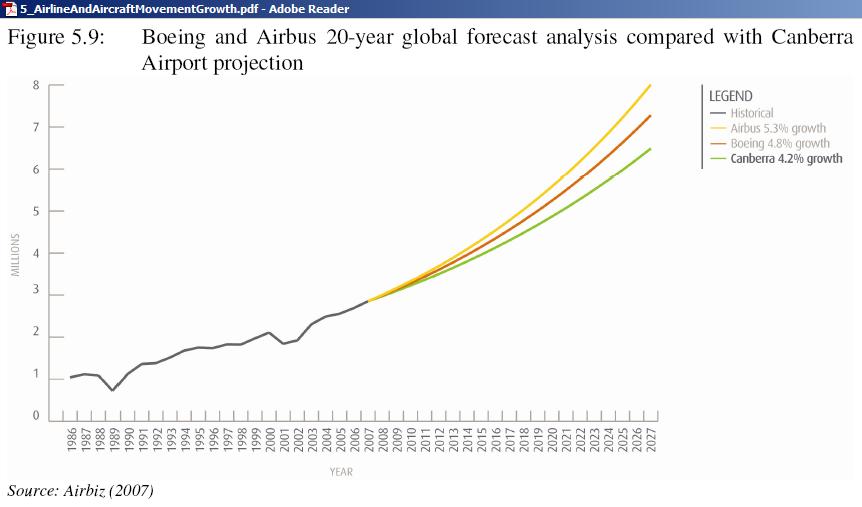 http://www.canberraairport.com.au/PDF/masterplan/approved/5_AirlineAndAircraftMovementGrowth.pdf
http://www.canberraairport.com.au/PDF/masterplan/approved/5_AirlineAndAircraftMovementGrowth.pdf
„The global aviation industry has been in a period of constant change over the last decade. The Australian aviation market was severely affected by the collapse of Ansett and its regional subsidiaries. Additional security requirements imposed as part of a focus on the risks of terrorism have added additional imposts on passenger travel and recent fluctuations in the oil price and the downturn in the global economy have challenged the airline industry worldwide. All of these factors have weakened potential growth opportunities at Canberra Airport.
Nevertheless, new airlines (including low-cost carriers), capacity and frequency increases, lower fares and new routes, as well as the growth of the regional economy, has led to improved prospects for the growth of airline services at Canberra Airport. Much like the experience in the United States and in Europe, evidence suggests aviation is undergoing a structural change due to the impact of low airfares, with people travelling by air where they would otherwise have driven or not travelled at all.“
The following consultants participated in the Canberra Airport Master Plan:
(a) Access Economics:
The potential demand for direct international flights between Canberra and Singapore, 2005
http://www.accesseconomics.com.au/publicationsreports/getreport.php?report=80&id=90
(b) Airbiz has this idea about how to solve the problem of airport congestion:
 http://www.airbiz.aero/assets/Uploads/Press/Airbiz%20Press%20Release%20%E2%80%94%20April%202007.pdf
http://www.airbiz.aero/assets/Uploads/Press/Airbiz%20Press%20Release%20%E2%80%94%20April%202007.pdf
2.4 Melbourne
Web Site: http://www.melbourneairport.com.au/About-Melbourne-Airport/Planning/Master-Plan.html
approved in December 2008
The forecasting methodology has been described as follows:
“BAA in consultation with Melbourne Airport has produced the forecasts for this Master Plan which cover a 20 year period from 2007/08 to 2027/28 BAA has completed a number of forecasts for Melbourne Airport. The FAC used BAA to calculate international passenger forecasts from 1986. APAM have used BAA for all forecasting post privatisation in 1997. Upper and lower limit forecasts are presented in this Plan. The resulting band encompasses any long term effect associated with economic cycles and the impact that they have on passenger and aircraft activity demand. These forecasts are based on various scenarios dealing with economic factors and aviation policy changes as described below, and cover:
• Historical Air Traffic Performance;
• Passenger movements;
• Aircraft movements; and
• International freight tonnage.
Specifically, passengers were projected using the econometric modelling approach which BAA uses for long term passenger forecasts. The model works by first splitting the base traffic volume into a series of categories according to passenger type and route group. The base data is sourced from the Australian Bureau of Statistics passenger database and normalised against passenger volumes. Economic factors used include gross domestic product, personal consumption, airfares (and the impact that fuel prices have on them) and exchange rates, as well as aviation policy changes such as international air services deregulation. This data along with varying economic assumptions relating to these passenger groups are used in the econometric model to obtain high and low forecasts”
“This Master Plan is subject to change. Accordingly, the development strategies and scenarios detailed in it are indicative only, and their inclusion is not to be read as an assurance that any, or all of them, will occur.”
http://www.melbourneairport.com.au/media/docs/planning/15581_MasterPlan_2008_FA9.pdf
That qualification was absolutely necessary because we find in this BAA projection for Heathrow
“For forecasting demand for passenger air traffic for the London area, BAA uses three different methods of demand forecasting for different time periods:
• in the short term, it extrapolates current trends and incorporates an assessment of airline intentions; and
• for medium- and long-term projections, the econometric model is used.
Oil prices
19. BAA took a considerably more pessimistic view on oil prices in January 2007, increasing its projections by $5–$10/barrel in real terms between 2006 and 2030 compared with its January 2006 forecasts. It surveyed a number of forecasters and looked at press comment and noted that the interim scenarios for NIER and OECD had recently increased their forecasts to $65–$67. Oxford Economics had not, however, changed its forecasts and they were still much lower. Jet fuel had recently risen above $2/gallon. BAA therefore considered that prices were likely to be high in the medium term, and that the increase in refining capacity and recovery from the 2005 hurricane Katrina was likely to have a limited effect. Planes were likely to become more efficient in the long term, and BAA had built in an increase of 1 to 1.5 per cent in this metric into its forecasts. If this increase in oil prices is reflected in airfares, it might be expected to deter passengers from flying, but it has a smaller effect on demand at Heathrow than on overall unconstrained demand in the south-east, as Heathrow is operating at capacity.
The airlines had not seen any major change in the oil price between September and January to justify the changes in BAA’s assumptions. Oil prices remained volatile in the short term but a five-year view showed a gradual easing of the oil price. They argued that there was some evidence that output would increase to match the current high level of prices, and that between March and June 2007, there had been unusually high demand which might ease. The airlines had also observed a widening in the margin between the prices of oil and of jet fuel, which might be reversed as more refining capacity came on stream (reversing the impact of hurricane Katrina).
Q5 traffic forecasts for Heathrow
http://www.caa.co.uk/docs/5/ergdocs/ccreport_appj.pdf
It is very clear here that BAA considered only short term movements of oil prices and relied on “press comments” but never thought about what happens when oil production declines. And BAA is based in a country in which oil production peaked in 1999, so the concept of peak oil should have been known to them first hand.
Colin Campbell’s 1999 warning to the House of Commons:
http://www.oilcrisis.com/Campbell/commons.htm
2.5 Perth
November 2009
Web site: http://www.perthairport.com.au/AboutUs/MasterPlan.aspx
“5.1 Forecast Methodology
A large number of factors influence the growth in air travel, the most significant ones being:
• disposable incomes of potential travellers; the level of income and confidence that these levels will be maintained and grow are both important;
• other general economic variables that affect aviation demand and supply such as exchange rates, interest rates and fuel prices;
• the competitiveness (quality, product attributes and price) of a destination compared to alternative destinations;
• the supply of airline services – frequency, reliability, quality of service;
• tourism promotion by Governments, airlines and industry bodies;
• consumer tastes and available time for travel; and
• one off factors and shocks. These include the travel impacts of events such as the Olympics, September 11, the collapse of an airline such as Ansett and health concerns such as those generated by SARS. While acknowledging that all such factors have an impact on air service demand, all factors cannot be reliably measured and/or used in the modelling to produce forecast data“ p 34
“Given the significant uncertainty that currently exists in relation to the outlook for Australian and global economic growth Perth Airport is likely to be reviewing the activity forecasts contained in this Master Plan to take into account developments including the International Monetary Fund’s recent downward revision of economic forecasts for many countries relevant to Perth Airport aviation demand.
This is likely to result in downward revision of Perth Airport’s activity forecasts, but not to the extent that would have a major impact on peak hour demand for important airport processes. Hence the airport development plans contained in this Master Plan are not expected to materially change” p 35
2.6 Adelaide
Web site: http://www.adelaideairport.com.au/corporate-and-community/community
 http://www.adelaideairport.com.au/assets/pdfs/master-planning/Vol1MaterPlanDec2009.pdf
http://www.adelaideairport.com.au/assets/pdfs/master-planning/Vol1MaterPlanDec2009.pdf
“4.3 PASSENGER AND AIRCRAFT MOVEMENT FORECASTS
In 2008, Tourism Futures International (TFI) in conjunction with Airbiz was commissioned by AAL to prepare long-term passenger and aircraft movement forecasts for Adelaide Airport.
Base Case – The approach to forecasting international passengers in the base case was to link the main economic and aviation drivers to traffic via elasticities derived from an analysis of Adelaide traffic behaviour and a review of many Australian and overseas studies. Relationships were developed for each of the main international markets and included in the forecasting models. Model drivers include country GDP, exchange rates and movements in airfares.
Aggregated models were also developed linking international visitors to OECD, GDP and the Australian Trade Weighted Index (TWI). The volume of overseas travel via Adelaide by Australian residents is linked to Australian GDP and the TWI.
To account for the economic slowdown and then stimulation associated with recovery and additional capacity, a period of mild market stimulation for 2010/11 and 2011/12 was assumed.
High scenario – It is assumed that GDP growth is 0.5 percentage points per year higher than for the Base forecast. It is also assumed that recovery from the economic problems of this year and next will lead to an increase in passenger performance of 2.0 per cent in each of 2010/11, 2011/12 and 2012/13.
Low scenario – It is assumed that GDP growth is 2 percentage points lower in the first five years than for the Base forecast and then 0.5 percentage points per year lower than for the Base forecast. It has also been assumed that capacity will fall below expectation and lead to further reductions in growth of 1 per cent in each of 2008/09 and 2009/10. Allowance has been made for capacity recovery in the period 2010/11 through to 2012/13.
4.3.1 Key Assumptions in the Forecasting
The following assumptions are key to the achievement of forecasts for Adelaide Airport:
TFI has assumed that the global economies will recover over a three year period such that into 2010/11 growth should be strengthening. The Australian economy is forecast to slow significantly;
TFI assumes that the value of the Australian dollar will trend to long-term average over the next five years. This will over time provide a stimulus to travel by overseas visitors and slow the growth of Australians travelling outbound;
TFI considers it likely that the longer-term trend for real (inflation adjusted) reductions in fares will continue. The advent of low cost airlines should encourage this trend. Full service airlines are also focused on cost cutting and in many cases have themselves established low cost airline subsidiaries;
Oil prices will increase over current levels but not to the USD140 levels they achieved in June and July 2008. TFI has assumed that fuel prices will have a neutral effect on fares over the next few years. However this may change if fuel prices were to increase quickly to higher levels. Crude oil prices need to be monitored closely;
Low cost airlines, including Jetstar and Tiger Airways, will continue to grow their domestic/international services into Adelaide. Qantas and Virgin Blue are assumed to continue to grow into Adelaide;
Airline capacity will grow in line with demand in the longer term; and
Aviation industry supply side issues such as air services, pilots and airport capacity will not impede growth.
It must be recognised that there are many sources of forecasting uncertainty:
there is considerable uncertainty at this time as to the direction of some of the major drivers such as economic growth; and
there are many unpredictable factors that can influence outcomes. These factors can lower average growth rates in the short to medium term. p 1-19
2.7 Darwin
Web site: http://www.darwinairport.com.au/property/master-plan
http://www.darwinairport.com.au/Portals/1/docs/commercial/DIA_ConsultationBrochure.pdf
2.8 Hobart
Web sit: http://www.hobartairport.com.au/corporate/doing-business-with-us/master-plan/
 “A key element used for forecasting passenger traffic for Hobart for the 2009 Master Plan has been to take forecasts from other airport Master Plans in the public domain, for airports with which Hobart has existing connections, and to weight these according to the proportion of passenger traffic to and from Hobart currently.”
“A key element used for forecasting passenger traffic for Hobart for the 2009 Master Plan has been to take forecasts from other airport Master Plans in the public domain, for airports with which Hobart has existing connections, and to weight these according to the proportion of passenger traffic to and from Hobart currently.”
In addition, the above air traffic forecast data has been assessed in the context of historic and future projections for other social and econometric factors for Tasmania including:
• Population growth;
• Employment;
• Gross State Product (GSP); and
• Tourism Australia projections.
The lower and higher bounds of the Melbourne forecast are respectively impacted by the other airport forecasts to create the following weighted average for forecasting for Hobart:
• Low Growth Scenario – 3.7% CAGR per annum;
• Medium Growth Scenario – 4.1% CAGR per annum; and
• High Growth Scenario – 4.4% CAGR per annum respectively.
The Medium Growth Scenario of 4.1% CAGR per annum has been chosen to take forward for forecasting at Hobart as it represents the most pragmatic forecast for long-term planning.
2.9 Sunmmary of Airport Master Plans
The following table gives an overview of whether and how aviation documents deal with oil supplies, oil prices, economic developments surrounding the global financial crisis and CO2 emissions. The consultants who participated in the preparation of these plans are also listed.
Related article:
27/2/2009
Submission Green Paper on Aviation
http://www.crudeoilpeak.com/?p=43
Note: As much as possible, links have been updated 4/8/2012
